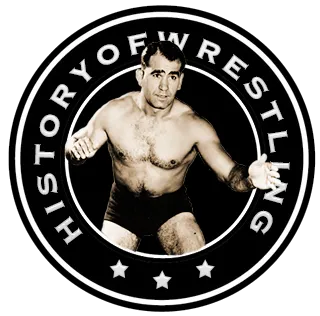by Stephen Von Slagle
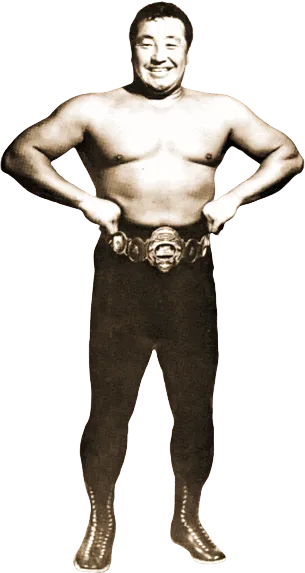 Although his name might not be easily recognized by many U.S. fans today, Rikidozan was once the most influential man in Japanese wrestling and, decades after his death, he still remains the most important man in the history of pro wrestling in that nation. It is widely acknowledged that had there been no Rikidozan, there would likely be no such thing as professional wrestling in Japan.
Although his name might not be easily recognized by many U.S. fans today, Rikidozan was once the most influential man in Japanese wrestling and, decades after his death, he still remains the most important man in the history of pro wrestling in that nation. It is widely acknowledged that had there been no Rikidozan, there would likely be no such thing as professional wrestling in Japan.
Rikidozan (which translates into “rugged mountain road”) was born Kim Sin-Nak on November 14, 1924 in North Korea. Because of the long history of discrimination by the Japanese against Koreans, Sin-Nak used the name Mitsuhiro Momota and claimed that he hailed from Nagasaki. While growing up, he encountered the Japanese prejudice against Koreans often and was known to have been quite bitter because of it. He kept his true identity a secret for his entire career and his true nationality was not revealed to the public until after his death. After training as a sumo, the man who would go on to rule Japanese pro wrestling began his career on October 28, 1951 in Tokyo, wrestling to a 10 minute draw against Bobby Bruns. Within a few years, and after spending some time in the U.S. honing his craft, the athletic and talented Rikidozan would nearly single-handedly lift professional wrestling in Japan from obscurity to a sport for the masses.
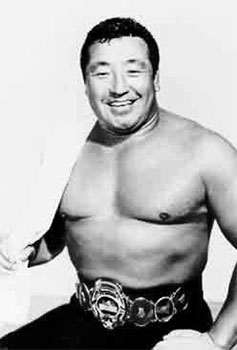 After they lost World War II, the Japanese people were understandably in a state of depression and looking for heroes that could help ease the pain of their everyday lives. The sport of pro wrestling was, literally, brand new to the Japanese public and Rikidozan became the biggest wrestling superstar in the country. By defeating American wrestler after American wrestler (who were portrayed as evil villians), Rikidozan helped win back some respect for Japan in the eyes of the Japanese people and in the process, he became a national hero. Rikidozan often expressed his contempt for American wrestlers, whom he saw as overweight cheaters, and he publically claimed that they were “soft” compared to their Japanese counterparts. It might not have made him popular with American fans, but the Japanese loved him for standing up to the Americans. In actuality, though, it was an American who truly put him over the top as Japan’s premier box-office attraction.
After they lost World War II, the Japanese people were understandably in a state of depression and looking for heroes that could help ease the pain of their everyday lives. The sport of pro wrestling was, literally, brand new to the Japanese public and Rikidozan became the biggest wrestling superstar in the country. By defeating American wrestler after American wrestler (who were portrayed as evil villians), Rikidozan helped win back some respect for Japan in the eyes of the Japanese people and in the process, he became a national hero. Rikidozan often expressed his contempt for American wrestlers, whom he saw as overweight cheaters, and he publically claimed that they were “soft” compared to their Japanese counterparts. It might not have made him popular with American fans, but the Japanese loved him for standing up to the Americans. In actuality, though, it was an American who truly put him over the top as Japan’s premier box-office attraction.
On October 6, 1957, over 27,000 spectators were on hand to witness NWA World champion Lou Thesz defend his title against Rikidozan in a sixty-minute draw. The much-anticipated match was broadcast nationally on television and garnered an unbelievable 87.0 rating, which is still the highest rated wrestling program in history and will likely remain so for a very long time. A year later, when Thesz (no longer the NWA champion) lost his International Heavyweight title to the Japanese superstar on August 27, 1958, it validated Rikidozan in the eyes of the wrestling world and cemented his status as an icon of Japanese culture. Lou Thesz, the most revered wrestler in the world at the time, was virtually the only American wrestler Rikidozan would publicly admit to having respect for. The respect was mutual and when Thesz “put him over” again by losing to Rikidozan in the final round of the 4th Annual World League Tournament on May 25, 1962, he knew he would be building Rikidozan’s reputation at the expense of his own. It was a gesture that Rikidozan would never forget, and a lesson he would pass on to his students (which included Giant Baba and Antonio Inoki) when training them for a career inside of the ring.
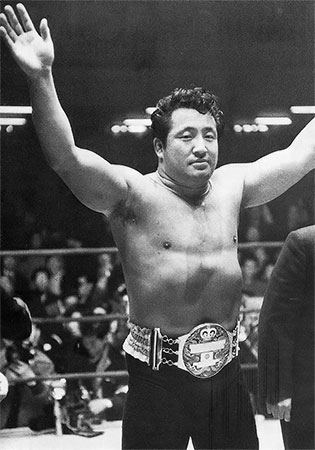 During his remarkable career, Rikidozan won numerous championships, including the Pacific Coast Tag Team title (with Dennis Clary) in 1952, the Japanese Heavyweight title in 1954, the Hawaiian Tag Team championship, the All-Asian Heavyweight title in 1955, the NWA World Tag Team title (w/Koukichi Endo) in 1956, the aforementioned International title in 1958, the All-Asian Tag Team title four times between 1960-1963 and the WWA World Heavyweight title (Los Angeles) in 1962. Additionally, in 1953 he was a founder (and, later, President) of the Japanese Wrestling Association, which for many years was the largest and most powerful governing body in Japan. Beginning in 1954, the JWA was broadcast nationally on both the Nippon and the NHK networks, with Rikidozan as the main attraction and the new programs garnered massive ratings. Much as Gorgeous George had done several years earlier in America, the popularity of Rikidozan (and, by extension, professional wrestling) helped the fledgling television industry in Japan immensely, establishing the new entertainment medium in that nation.
During his remarkable career, Rikidozan won numerous championships, including the Pacific Coast Tag Team title (with Dennis Clary) in 1952, the Japanese Heavyweight title in 1954, the Hawaiian Tag Team championship, the All-Asian Heavyweight title in 1955, the NWA World Tag Team title (w/Koukichi Endo) in 1956, the aforementioned International title in 1958, the All-Asian Tag Team title four times between 1960-1963 and the WWA World Heavyweight title (Los Angeles) in 1962. Additionally, in 1953 he was a founder (and, later, President) of the Japanese Wrestling Association, which for many years was the largest and most powerful governing body in Japan. Beginning in 1954, the JWA was broadcast nationally on both the Nippon and the NHK networks, with Rikidozan as the main attraction and the new programs garnered massive ratings. Much as Gorgeous George had done several years earlier in America, the popularity of Rikidozan (and, by extension, professional wrestling) helped the fledgling television industry in Japan immensely, establishing the new entertainment medium in that nation.
Aside from being Japan’s top pro wrestler and an elite celebrity in Japanese culture, Rikidozan was also a very successful businessman and by the end of his life he had acquired a vast empire which included his wrestling and boxing promotions as well as hotels, golf courses, night clubs, and real estate holdings.
However, those business interests would eventually bring him into contact with the violent underworld of Japan’s crime syndicate gangsters. On December 8, 1963 he had an argument with a low-level gangster in a fashionable Tokyo hotspot and was stabbed in the torso. Shrugging off the injury, he continued drinking and partying throughout the evening before eventually seeking medical attention. This decision proved to be fatal as within a week he had contracted peritonitis and required major surgery, from which he did not recover.
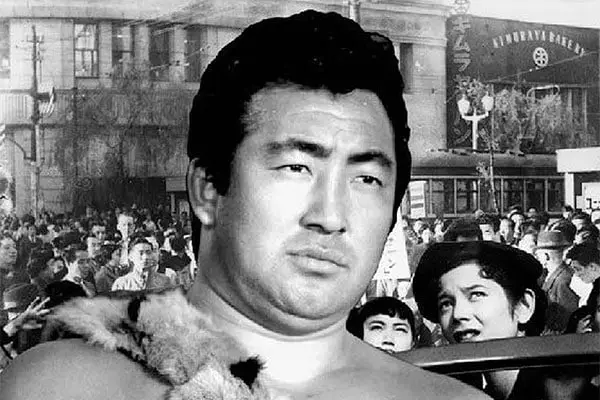
Thousands of mourners attended his funeral on December 20, 1963. The death of Rikidozan was, to say the least, a major loss for pro wrestling in Japan. But, more importantly, the scandalous details regarding his true nationality and ties to organized crime that came out in the press after his death were so shattering that the sport he championed nearly died along with him. Pro wrestling went into a tailspin after his death, with many venues refusing to book wrestling shows and gate receipts fell off drastically. Obviously, the sport eventually recovered and, indeed, prospered, but it took his two brightest students, Giant Baba and Antonio Inoki and several years of rebuilding to keep Rikidozan’s legacy alive.
Rikidozan is a member of the Wrestling Observer Newsletter Hall of Fame (1996), the Professional Wrestling Hall of Fame and Museum (2006), the NWA Hall of Fame (Class of 2011), the WWE Hall of Fame (Class of 2017), and the International Professional Wrestling Hall of Fame (2021).
Kim Sin-Nak, a.k.a. Rikidozan, died on December 15, 1963 of peritonitis at the age of 39.
